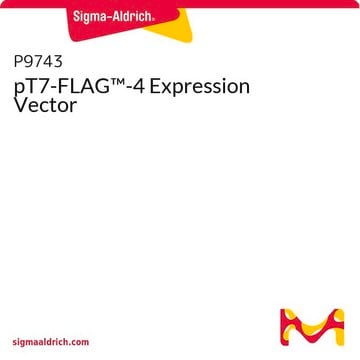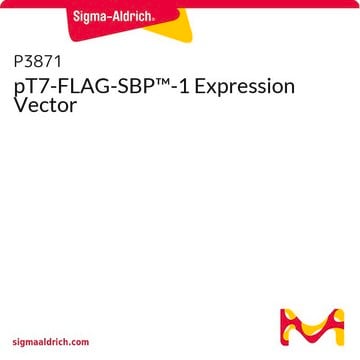おすすめの製品
タグ
6-His tagged
maltose-binding protein (MBP) tagged
フォーム
buffered aqueous solution
分子量
size 7295 bp
微生物選択
kanamycin
哺乳類細胞選択
puromycin
複製起点
pUC (500 copies)
ペプチド切断
3C
ペプチドタグ位置
N-terminal
プロモーター
Promoter name: CMV
Promoter activity: constitutive
Promoter type: mammalian
レポーター遺伝子
none
輸送温度
ambient
保管温度
−20°C
詳細
This plasmid is designed to express tagged proteins in mammalian cells either by transient transfection or by creating stable cell lines. It contains a puromycin resistance expression cassette using the human Ubiquitin promoter to drive expression and allow for the selection of cells containing the plasmid.
About the Peptide Tag:This plasmid contains an n-terminal Maltose Binding Protein (MBP) affinity tag that can be fused to a gene of interest to allow protein detection and/or purification. The sequence of the tag is: EEGKLVIWINGDKGYNGLAEVGKKFEKDTGIKVTVEHPDKLEEKFPQVAATGDGPDIIFWAHDRFGGYAQSGLLAEITPDKAFQDKLYPFTWDAVRYNGKLIAYPIAVEALSLIYNKDLLPNPPKTWEEIPALDKELKAKGKSALMFNLQEPYFTWPLIAADGGYAFKYENGKYDIKDVGVDNAGAKAGLTFLVDLIKNKHMNADTDYSIAEAAFNKGETAMTINGPWAWSNIDTSKVNYGVTVLPTFKGQPSKPFVGVLSAGINAASPNKELAKEFLENYLLTDEGLEAVNKDKPLGAVALKSYEEELAKDPRIAATMENAQKGEIMPNIPQMSAFWYAVRTAVINAASGRQTVDEALKDAQTNSSS. This plasmid also contains a secondary Hexa-Histidine (6His) protein tag. The sequence of this tag is: HHHHHHWe provide a range of dual peptide tag plasmids. This is because some peptide tags provide specific biological properties (e. g., small molecule affinity new epitopes solubility or protein secretion) that are not provided by others.
About the Cleavage Tag: This plasmid also encodes a protease cleavage site that is designed to be positioned between your gene of interest and the tag to allow the removal of the tag following protein purification or isolation. This plasmid contains a 3C cleavage tag. The protein sequence of the cleavage tag is: LEVLFQGP. Human Rhinovirus (HRV) 3C Protease is a highly specific protease that cleaves between the Glu and Gly residues of its recognition site. It is often produced with the trademname ′PreScission protease′.
Promoter Expression Level: This plasmid contains the mammalian CMV promoter to drive gene expression. We have tested all of our mammalian promoters in a range of cell types and CMV is consistently the strongest in those we have studied. However there are many reports of the CMV promoter demonstrating silencing by methylation in long-term culture. For this reason we stock a range of other promoters that are compatible with this plasmid and are available on request.
About the Peptide Tag:This plasmid contains an n-terminal Maltose Binding Protein (MBP) affinity tag that can be fused to a gene of interest to allow protein detection and/or purification. The sequence of the tag is: EEGKLVIWINGDKGYNGLAEVGKKFEKDTGIKVTVEHPDKLEEKFPQVAATGDGPDIIFWAHDRFGGYAQSGLLAEITPDKAFQDKLYPFTWDAVRYNGKLIAYPIAVEALSLIYNKDLLPNPPKTWEEIPALDKELKAKGKSALMFNLQEPYFTWPLIAADGGYAFKYENGKYDIKDVGVDNAGAKAGLTFLVDLIKNKHMNADTDYSIAEAAFNKGETAMTINGPWAWSNIDTSKVNYGVTVLPTFKGQPSKPFVGVLSAGINAASPNKELAKEFLENYLLTDEGLEAVNKDKPLGAVALKSYEEELAKDPRIAATMENAQKGEIMPNIPQMSAFWYAVRTAVINAASGRQTVDEALKDAQTNSSS. This plasmid also contains a secondary Hexa-Histidine (6His) protein tag. The sequence of this tag is: HHHHHHWe provide a range of dual peptide tag plasmids. This is because some peptide tags provide specific biological properties (e. g., small molecule affinity new epitopes solubility or protein secretion) that are not provided by others.
About the Cleavage Tag: This plasmid also encodes a protease cleavage site that is designed to be positioned between your gene of interest and the tag to allow the removal of the tag following protein purification or isolation. This plasmid contains a 3C cleavage tag. The protein sequence of the cleavage tag is: LEVLFQGP. Human Rhinovirus (HRV) 3C Protease is a highly specific protease that cleaves between the Glu and Gly residues of its recognition site. It is often produced with the trademname ′PreScission protease′.
Promoter Expression Level: This plasmid contains the mammalian CMV promoter to drive gene expression. We have tested all of our mammalian promoters in a range of cell types and CMV is consistently the strongest in those we have studied. However there are many reports of the CMV promoter demonstrating silencing by methylation in long-term culture. For this reason we stock a range of other promoters that are compatible with this plasmid and are available on request.
シーケンス
To view sequence information for this product, please visit the product page
アナリシスノート
To view the Certificate of Analysis for this product, please visit www.oxgene.com
関連製品
製品番号
詳細
価格
保管分類コード
12 - Non Combustible Liquids
引火点(°F)
Not applicable
引火点(℃)
Not applicable
適用法令
試験研究用途を考慮した関連法令を主に挙げております。化学物質以外については、一部の情報のみ提供しています。 製品を安全かつ合法的に使用することは、使用者の義務です。最新情報により修正される場合があります。WEBの反映には時間を要することがあるため、適宜SDSをご参照ください。
Jan Code
OGS1261-5UG:
最新バージョンのいずれかを選択してください:
Alexander C Cerny et al.
PLoS genetics, 11(10), e1005578-e1005578 (2015-10-29)
Recycling of signaling proteins is a common phenomenon in diverse signaling pathways. In photoreceptors of Drosophila, light absorption by rhodopsin triggers a phospholipase Cβ-mediated opening of the ion channels transient receptor potential (TRP) and TRP-like (TRPL) and generates the visual
Geoffrey M Lynn et al.
Nature biotechnology, 33(11), 1201-1210 (2015-10-27)
The efficacy of vaccine adjuvants such as Toll-like receptor agonists (TLRa) can be improved through formulation and delivery approaches. Here, we attached small molecule TLR-7/8a to polymer scaffolds (polymer-TLR-7/8a) and evaluated how different physicochemical properties of the TLR-7/8a and polymer
Diana Romero et al.
Carcinogenesis, 37(1), 18-29 (2015-10-28)
Dickkopf-3 (Dkk-3) is a secreted protein whose expression is downregulated in many types of cancer. Endogenous Dkk-3 is required for formation of acini in 3D cultures of prostate epithelial cells, where it inhibits transforming growth factor (TGF)-β/Smad signaling. Here, we
Jin-Gyoung Jung et al.
PLoS genetics, 10(10), e1004751-e1004751 (2014-10-31)
The Notch3 signaling pathway is thought to play a critical role in cancer development, as evidenced by the Notch3 amplification and rearrangement observed in human cancers. However, the molecular mechanism by which Notch3 signaling contributes to tumorigenesis is largely unknown.
ライフサイエンス、有機合成、材料科学、クロマトグラフィー、分析など、あらゆる分野の研究に経験のあるメンバーがおります。.
製品に関するお問い合わせはこちら(テクニカルサービス)





